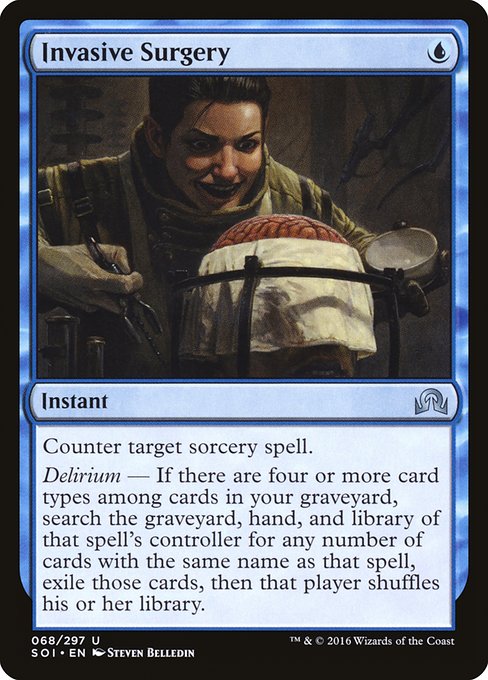
Image courtesy of Scryfall.com
Tracking a single blue instant across formats: a data-driven performance tale
Blue has always thrived on tempo and information, but Invasive Surgery from Shadows over Innistrad gives players a twist: a one-mana counterspell with a Delirium-powered secondary effect that can reshuffle a match’s strategic landscape. As we explore longitudinal performance across sets and formats, this card serves as a compelling case study in how a mid-range control tool behaves when the battlefield shifts around it 🧙♂️🔥. The dish is simple on the surface—a counter spell for a sorcery—but the delirium clause invites a data-driven look at deckbuilding, graveyard fueling, and how different metagames reward or punish the card’s conditional power.
Let’s start with the basics. Invasive Surgery costs a single blue mana, a rarity-leaning Uncommon in Shadows over Innistrad (SOI). It reads: “Counter target sorcery spell. Delirium — If there are four or more card types among cards in your graveyard, search the graveyard, hand, and library of that spell's controller for any number of cards with the same name as that spell, exile those cards, then that player shuffles.” That second half is the real data generator. When delirium is online, you not only stop the spell right there, you actively prune an opponent’s resources by removing copies of the very spell you countered. It’s a little surgical, a lot cunning, and absolutely blue in flavor 💎⚔️.
Card profile at a glance
- Set: Shadows over Innistrad (SOI)
- Mana cost: {U}
- Color: Blue
- Type: Instant
- Rarity: Uncommon
- Keywords: Delirium
- Core effect: Counter target sorcery spell
- Delirium condition: Four or more card types in your graveyard unlocks a powerful search-and-exile clause
From a gameplay perspective, the card shines in decks built around delirium convergence: you’re intentionally populating your graveyard with a diverse mix of card types—creatures, artifacts, enchantments, instants, sorceries, and lands—so that the delirium window cracks open at the right moment. The immediate tempo play of countering a sorcery is valuable, but the race to four card types in the graveyard creates a measurable arc that can swing games in formats that reward graveyard interaction, such as Legacy, Vintage, Modern, and Commander variants. In EDH especially, those pathways to delirium can feel like a puzzle piece that slots neatly into blue control shells 🧙♂️🎲.
Longitudinal implications across formats
Across sets and formats, Invasive Surgery tends to perform best when the metagame rewards selective graveyard interaction and resilient counterplay. In Modern and Legacy, where the pace is brisk and answers are precious, a one-mana counterspell with a heavyweight Delirium trigger can buy crucial turns early, then, if the delirium condition is met, deny a broader suite of threats by exiling copies of the spell from an opponent’s own zones. In Historic and other Eternal formats, the dynamics shift again: delirium becomes a lever for control players who are already populating their graveyard with a diverse spread of cards, creating a surprising engine that can stall or convert games late into the match. The art by Steven Belledin—the stark, clinical linework that mirrors surgical precision—only heightens the sense that this is a card built around exacting, data-minded play 🧭🎨.
“When data says a card should shine, you trust the numbers—but you still feel the thrill of a perfectly timed counter that hasn’t just stopped a spell, but rebalanced the battlefield.”
In practice, any data-driven examination of Invasive Surgery should track these signals: how often the delirium window actually opens given a typical blue build; how frequently the exile clause removes a critical copy the opponent relied on; and whether the corresponding deck archetypes in a given format actually tilt toward a delirium-rich graveyard or toward a more pure counter-policy. The dual-layer design—a straightforward counter plus a powerful, conditional graveyard-based fetch—creates a broad envelope for analysis, including how players mutate their deck to optimize the delirium trigger while maintaining reliable countermagic. In other words, this is a card that rewards both precise play and thoughtful data collection 🧠💡.
The art, the lore, and the practical takeaway
Beyond the numbers, Invasive Surgery offers a window into Innistrad’s flavor: a blink-of-an-eye moment where a spell’s name becomes a thread that can unravel an opponent’s strategy across their own deck. The Deep Blue sleight of hand pairs with the delirium mechanic to craft a narrative of memory and machine—where the graveyard is both archive and toolkit. collector value in the long run is modest, but the card remains a staple for players who enjoy weaving graveyard-centric or tempo-rich games into their plan. And yes, the foil versions tend to fetch a touch more in markets that track delirium synergy enthusiasts 🔥🎯.
For fans planning a multi-set, data-informed approach to blue control, Invasive Surgery is a reminder that sometimes the most impactful plays aren’t the loudest. They’re the ones that quietly shape opportunities for the rest of your deck across multiple turns. That’s the beauty of MTG: a single card, across formats, can deliver a surprisingly persistent storyline—one where data and taste go hand in hand 🧙♂️💎.
Phone Case with Card Holder MagSafeMore from our network
- https://blog.digital-vault.xyz/blog/post/mtg-rarity-vs-mana-cost-orcish-settlers-explained/
- https://blog.digital-vault.xyz/blog/post/cognitive-load-and-grinning-totem-navigating-mtgs-complex-interactions/
- https://blog.rusty-articles.xyz/blog/post/design-trends-for-the-next-decade-magsafe-card-holder-phone-case/
- https://crypto-acolytes.xyz/blog/post/crypto-and-international-law-navigating-global-challenges/
- https://transparent-paper.shop/blog/post/minimum-viable-product-strategy-a-lean-startup-guide/